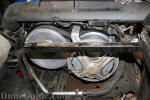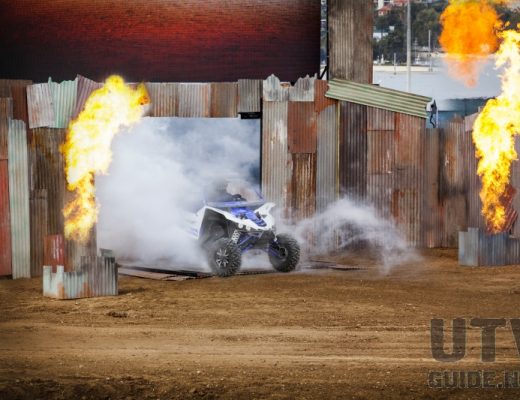| Yamaha Rhino CVT Belt Guide
Constant Variable Transmission or CVT The job of the transmission is to change the speed ratio between the engine and the wheels. The transmission uses a range of gears — from low to high — to make more effective use of the engine’s torque as driving conditions change. The gears can be engaged manually or automatically. Today’s side x side vehicles all use a type of automatic transmission called a continuously variable transmission or CVT. Unlike traditional automatic transmissions used in cars that are much too heavy for a side x side vehicle, CVTs don’t have any sort of gears. The CVT operates on a pulley system that allows an infinite variability between highest and lowest gears with no discrete steps or shifts. CVTs used in Rhinos, RZRs, Rangers, Teryx and Prowlers have three basic components:
The variable-diameter pulleys are the key to a CVT. Each pulley is made of two cones facing each other. A belt rides in the groove between the two cones. When the two cones of the pulley are far apart, the belt rides lower in the groove, and the radius of the belt loop going around the pulley gets smaller. When the cones are close together, the belt rides higher in the groove, and the radius of the belt loop going around the pulley gets larger. One of the two pulleys is connected to the crankshaft of the engine. This pulley is typically called the drive pulley. The second pulley is called the driven or output pulley because the first pulley is turning it. The driven pulley transfers energy to the transfer case and onto the differentials, through the axles and out to the wheels. CVT Air Filter? Lots of people have been sold on the need to put aCVT air filter on their Rhino to prevent debris from entering the belt area. While it isn’t a great idea to get sand in your CVT, a dirty CVT filter may cause even more damage. While the filter does help keep the belt area cleaner, there is debate on whether a dirty CVT Filter causes more heat in the CVT area leading to belt failure. While running a high speeds for extended periods of time, a lot of heat is generated. the area is cooled by fresh air. If you have a CVT filter that is clogged up, you are hampering the cooling of your belt and this can cause a belt failure. Most people suggest not using air filter oil on your CVT breather as it will more quickly clog your air filter and slow down the flow of cool air into your CVT. CVT Belt Failure While on our Mexico UTV Run in May 2008, our group experienced four CVT belt failures. Every Rhino that had a belt failure was running with a CDI and a CVT air filter. There are a few theories to why the belts failed. Some thought the aftermarket CVT filters are not letting enough cool air in. Others thought the CDI which allows higher speeds was the cause. Excess heat is a real killer of CVT belts. Excess heat is created by belt slippage. The belt is cooled by air flow, so anything you do to slow the flow of air over your belt will make your belt even more hot. CVT belts slip as a normal part of operation, but limiting the amount of slip is key. Adding extra weight to the vehicle without changing how the clutch operates will cause more slipping. So will over size tires and added performance (pipe, air filter and other performance work). Added stress on the engine while driving in mud or in the sand dunes will also create belt slip. While it is impossible to set up a clutch on a UTV to handle all variations or vehicle weight, horsepower and driving conditions, it is possible to adjust your clutch with different springs and weights for the majority of conditions. Think of it as tuning your CVT to your vehicle modifications and riding areas. A spare CVT belt is a good thing to keep with your Rhino at all times. How to change a Rhino CVT Belt Remove seat base and plastic in front of seat. Remove bolt from inner/front seat base that goes around below shifter. Remove the bolt holding hose clamp for the coolant line. Push hose down and out of the way so you can remove the clutch case housing through framed opening. Remove cover. Bolt lengths vary so make sure you mark them. Cover removed – Sheave is on the right. Remove sheave “guard” Guard removed In order to remove tension from the V-Belt, it is necessary to install two bolts into the secondary fixed sheave. Links:
Replacement Rhino CVT Belts
– Neoprene compounding.
– The highest quality belt available.
Clutch KitsAfter you have made a few changes to your Rhino, it may be a good time to think about a clutch kit. CVT belts slip as a normal part of operation, but limiting the amount of slip is key to longer belt life and performance. While it is impossible to set up a clutch on a UTV to handle all variations or vehicle weight, horsepower and driving conditions, it is possible to adjust your clutch with different springs and weights for the majority of conditions that apply for you. A typical clutch kit will come with a secondary spring and weights. Changing the springs for the secondary sliding sheave will help manipulate progression rate and engagement RPM. If you want to play around with creating your own “kit” there are a few things to keep in mind. In general, there are a few different spring choices: Clutch weights are available in 14 gram, 16 gram, or 18 gram weights. Different clutch weights have a direct affect on both progression rate and engagement RPM. Other kits may also include a new severe duty belt and sprague springs.
Yamaha Rhino Clutch Kits – EPI Yamaha Rhino Clutch Kit (Duner’s Kit) fromKMS Performance Yamaha Rhino Clutch Kits – Alba Action |




















No Comments